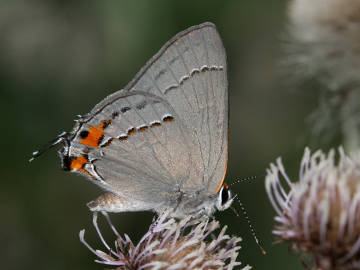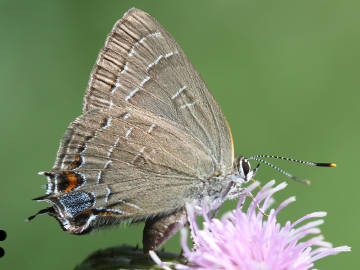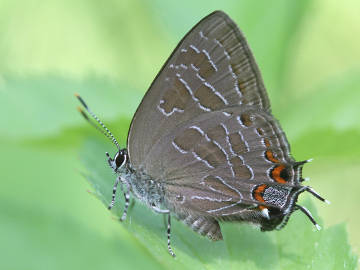

PHOTO COURTESY OF GARRY KESSLER
Gray hairstreak.
July 13, 2012, Page 4
NATURE NOTES
By Annie Reid
Westborough Community Land Trust
Seeing Small Butterflies
Have you recently caught sight of a large, colorful butterfly – maybe a yellow and black-striped tiger swallowtail, an orange and black monarch or viceroy, a black swallowtail with yellow or blue markings, or an orange fritillary? If so, even if you don’t know its name, it’s a reminder that butterfly season peaks in July. This is the perfect time to notice some of the many smaller, less obvious butterflies going about their lives.
A good place to look for both large and small butterflies is on milkweed, which blooms in Westborough’s fields, roadsides, and wildflower gardens in late June and early July. Many kinds and sizes of butterflies (and other insects) come to sip its nectar, and monarch butterflies lay eggs on it. Most of our milkweed is common milkweed (Asclepias syriaca), with large ball-shaped flower heads with small purplish blossoms. We also have swamp milkweed (Asclepias incarnata), typically bordering ponds and swamps, with flat-topped clusters of deep pink blossoms. Some of Westborough’s gardens include brilliant orange butterfly weed (Asclepias tuberosa), a milkweed that thrives on Cape Cod.
Small butterflies also seek out wild plants with smaller, shallower blossoms (such as Canada thistle, meadowsweet, dogbane, New Jersey tea, and sumacs). Small butterflies like these plants for a very practical reason – their short “tongues,” a human label for the butterfly proboscis, which is the long, straw-like mouth part that butterflies uncurl and use to suck up nectar. Large butterflies with longer tongues can drink from deeper tube-like flowers. Imagine having your lifestyle determined by the length of your tongue!

PHOTO COURTESY OF GARRY KESSLER
Banded hairstreak
Hairstreaks are one group of small butterflies of late June and July. And small means small! These little native butterflies typically have wingspans of only about 1-1/4 inches, but when they perch with wings closed and upright, they’re only about half an inch in size. Many have hair-like “tails” on their hind wings, which may be a reason for their name.
Hairstreaks fly fast and erratically, so their flight can be hard to follow, but they also like to perch on plants, giving you a chance for a peek at the delicate pattern of markings on the undersides of their wings.
To find hairstreaks, look for small gray butterflies. That may not sound very exciting, but the colorful white, black, orange, and blue markings on the undersides of their wings are well worth a look. You might find gray hairstreaks (Strymon melinus), banded hairstreaks (Satyrium calanus), striped hairstreaks (Satyrium liparops), or others. These common names – gray, banded, or striped – reflect features of their different patterns.
These little butterflies frequent the edges of woods and brushy fields, so watch for them there. Powerline cuts can be good places for hairstreaks. Look for them at the Mass Fish and Wildlife Management Area in Westborough, or along the Charm Bracelet trail going up through the fields on Cedar Hill (just over the line in Northborough). Or check the New Jersey tea in a back corner of the WCLT wildflower garden at the Andrews Street entrance to the Headwaters Conservation Area. If you visit Audubon’s Broad Meadow Brook wildlife sanctuary in Worcester (off Massasoit Road near Route 20), walk the powerline trail and look for them there.

PHOTO COURTESY OF GARRY KESSLER
Striped hairstreak
It’s no coincidence that these hairstreaks like woodland edges and fields. The plants that they eat in their caterpillar stage eat grow there. Gray hairstreak caterpillars can feast on the flowering parts of plants in 29 different families. Banded and striped hairstreak caterpillars consume the buds and young leaves of trees. Banded hairstreak caterpillars like oaks but also hickories and walnuts. Striped hairstreak caterpillars munch wild cherry trees, as well as apple, pear, certain oaks, ash, quaking aspen, raspberry, highbush blueberry, and more.
The gray, banded, and striped hairstreaks that you might see this summer got their start a whole year ago. Last summer, females laid eggs – on flower heads or flower buds of caterpillar food plants in the case of gray hairstreaks, and near the ends of twigs of the right trees or shrubs in the cases of banded and striped hairstreaks.
During last summer and fall, gray hairstreak caterpillars hatched, ate, and formed their chrysalises, which are protective casings in which they then overwintered and transformed into butterflies. In early spring of this year, the adult gray hairstreak butterflies emerged. The ones we see now are either those butterflies, or another generation from an early round of egg-laying.
You might spot a gray hairstreak basking in the sun with its wings open. In this view, the upper sides of its wings are dark gray with an orange-and-black eyespot on the edge of each hind wing. Or you might see it perched with wings closed as it takes nectar from a flower or sits on foliage and (in the case of a male) waits for a female to come by.
This summer’s banded and striped hairstreaks survived the winter as eggs, conveniently placed on twigs near the leaf buds that fed the caterpillars when they hatched in the spring. The little green caterpillars then ate, grew, formed chrysalises, and transformed into the adult banded and striped hairstreak butterflies that we see now.
Are butterflies feisty? You might think so if you see two – or more – male banded hairstreaks engaged in swirling combat, flying in tight circles around one another and rising fast and high into the air. As they wait for females, these males perch on plants and fly out to defend their chosen patch of territory from rivals. Gray hairstreaks, too, will fend off other males in a similar fashion.
Striped hairstreaks are more peaceful. They too perch and wait for females, but they’re much less likely to pick a fight with another male. You’re more likely to see striped hairstreaks by themselves, rather than groups.
To protect themselves from predators, hairstreaks rely on deceptive aspects of their appearance. In a side view, their tails look like antennae, and orange or blue eyespots draw the attention of a predator, such as a bird, to the back of the butterfly. This tends to spare the butterfly’s head and body from damage in an attack.
If you watch a perched hairstreak, you might notice it turning itself so you see it edge-on, not from the side. In this perspective, the butterfly looks very skinny, almost like a thin line, and its antennae stick out from the sides. It is hard to see, and even harder to recognize as a butterfly. It’s probably no accident that the butterfly is hiding from you in this way.
Westborough also has the Hessel’s hairstreak (Callophrys hesseli), listed as a species of special concern in Massachusetts. This small green butterfly has white and reddish-brown markings, somewhat similar to the more common and closely related juniper hairstreak (Callophrys gryneus). Hessel’s hairstreaks live in Cedar Swamp but haven’t been officially seen in town since 1988. Their caterpillars are specialized, feeding only on Atlantic white cedar (Chamaecyparis thyoides) trees in the swamp. The adult butterflies are out at a time in the spring when Cedar Swamp is not very accessible to people, due to high water (from the second week of May to the second week of June).
If you watch for small butterflies this summer, you might suddenly find yourself noticing other small butterflies besides hairstreaks, such as browns, coppers, and some of the vast number of skippers. There’s a whole world of small butterflies out there!